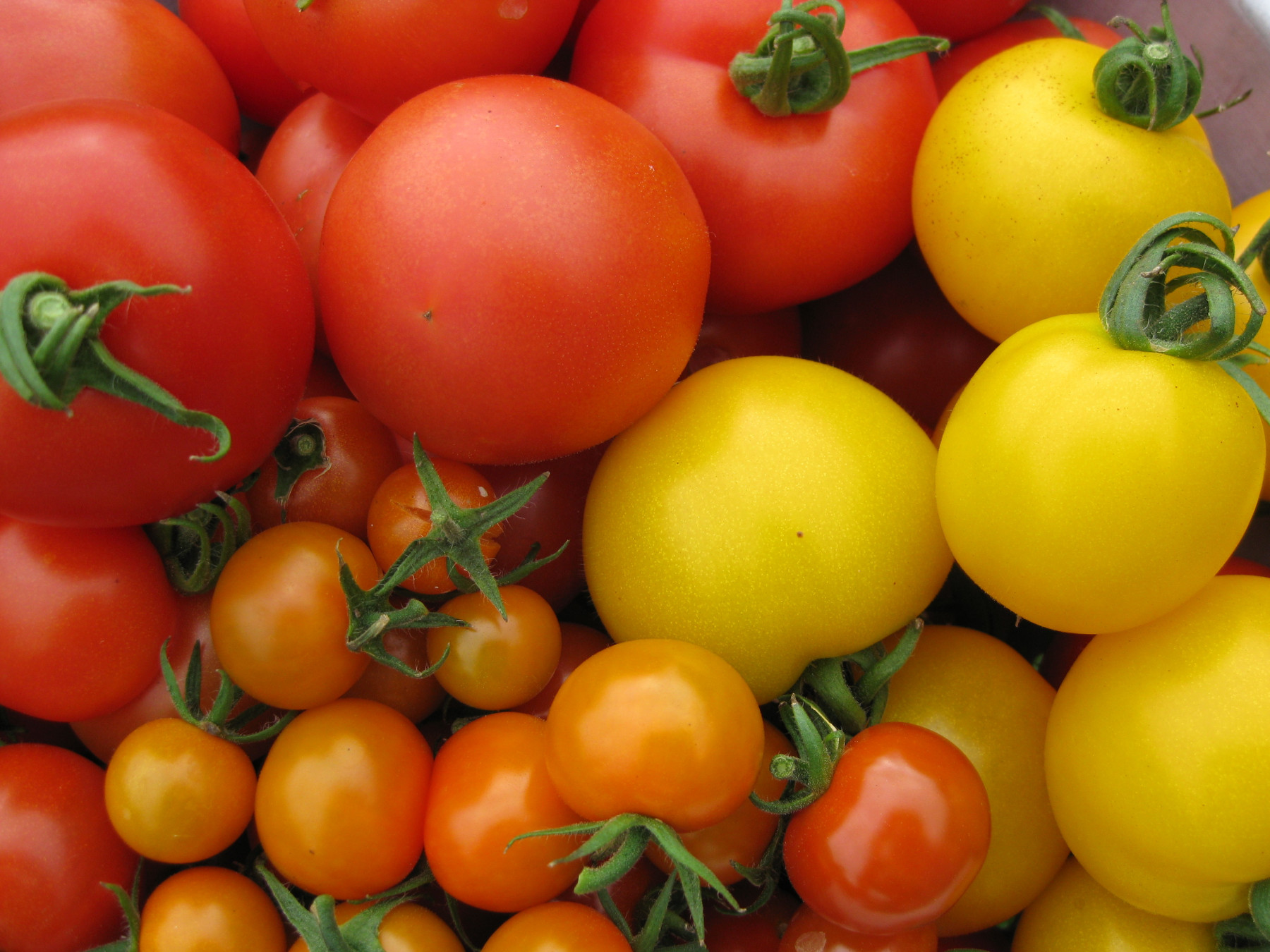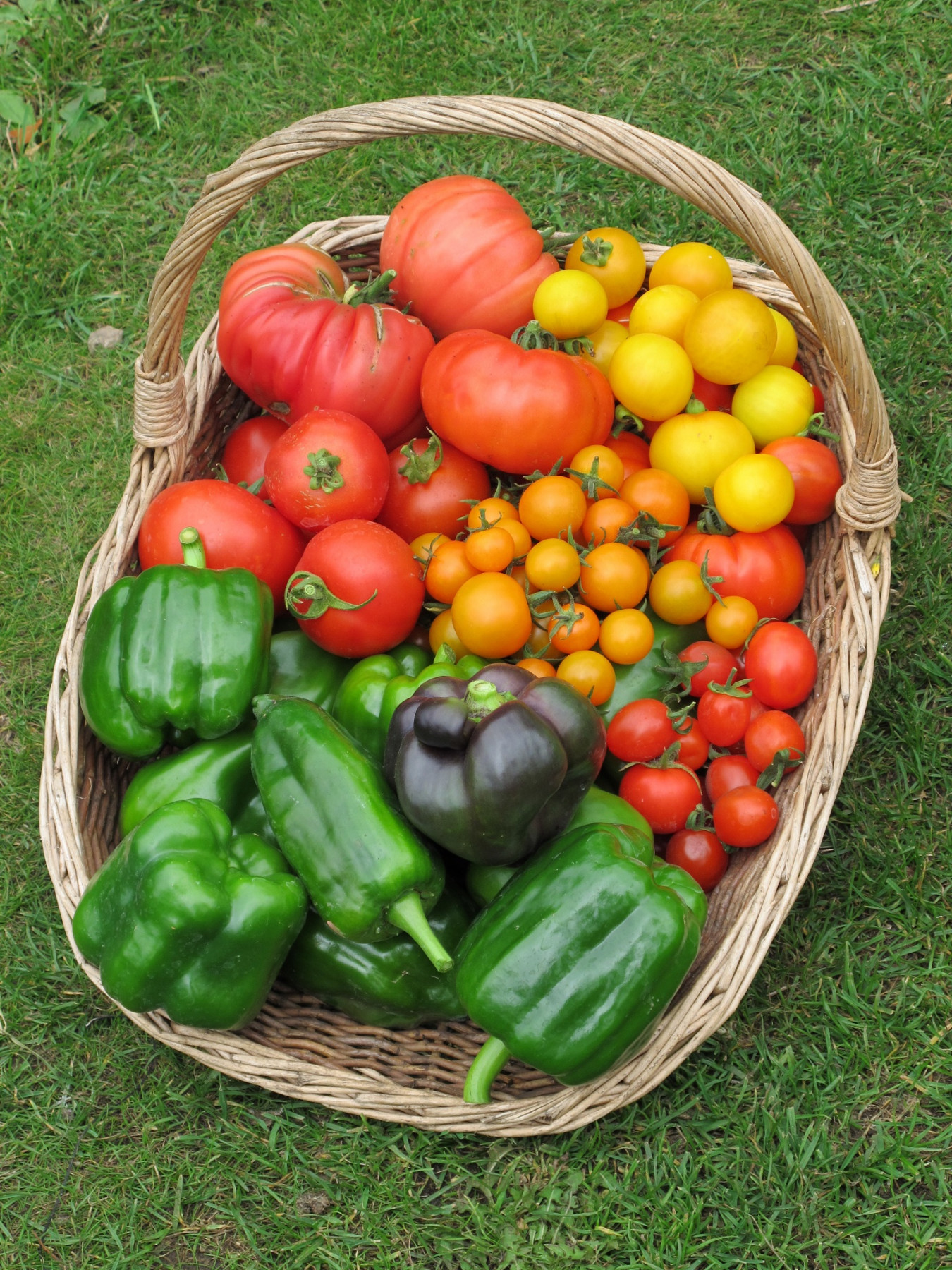
There is nothing quite like a home-grown, sun-warmed tomato picked fresh from the greenhouse and a fair few of mine never reach the table when the grandchildren are sent out to hunter gather! We grow lots of different types from cherry, to plum, to beefsteak, to medium-sized and round and, although we major on reds, we also grow some orange and yellow varieties because they add more eye appeal to a plate of food.
We wouldn’t be able to grow tomatoes without our Hartley greenhouse, because it’s too exposed in the cold Cotswolds. Growing a range of types gives us a wider range of harvest times, because cherry tomatoes ripen earlier than others. Large beefsteaks end the season for us and most of these are made into passata and frozen, using what looks like a large red mincing machine. This gem was acquired from Seeds of Italy for roughly £30.00, some years ago, and it’s worth its weight in gold. On a winter’s evening we can still taste a touch of summer in casseroles, Bolognese sauce, soups and pizzas. Cooked tomato is very healthy because the lycopene, a powerful carotenoid and antioxidant, is more readily absorbed by the body when tomatoes are cooked. The lycopene is also said to decrease your risk of bone loss, cancer, stroke and even sunburn.
We only grow four or five cherry tomato plants and the orange-fruited ‘Sungold’ is the chosen one because of its fine flavour, health and vigour. It will fruit about three months after sowing and we generally start our tomatoes off in March, using a heated Vitopod propagator, and will pick the first Sungolds in early July. You can now buy ready-grown grafted plants of ‘Sungold’ ( and other varieties) and grafted plants are more disease resistant. ‘Gardener’s Delight’ is the usual red and you should expect roughly a hundred fruits from each cherry tomato, because the trusses usually contain over twenty well-spaced fruits.‘Sungold’ is less likely to split than ‘Gardeners’ Delight’, should your watering regime be a little patchy – and ours sometimes is!
When it comes to watering I keep my fully grown plants on the dry side for the first three weeks or so, to encourage deeper roots. Thereafter, I find a daily morning watering suits tomatoes best. They seem to grow better and the water has time to evaporate before the greenhouse is shut for the night. Moist, damp warm nights can encourage fungal diseases. Give them a good soaking in the morning and plenty of fresh air afterwards. Don’t sprinkle, thoroughly water but try to keep the water away from the foliage if possible.

It’s important to know that wild tomatoes are natives of South America and their wild ancestors were rambling vines found in a variety situations. Wild species were found in Peru, Bolivia, Chile and Ecuador, often at altitude. They were cultivated by the Aztecs and Incas as early as 700 AD and the English word ‘tomato’ comes from the Aztec word tomatl. The French were convinced that tomatoes had aphrodisiac properties and called them pommes d’amour or love apples. Personally, I haven’t noticed!
Cultivated tomatoes began life in the warm climate of Mexico, where days are evenly balanced with twelve hours of daylight. They are very frost tender. A good frost kills them off, just as it does dahlias. Cold nights, which happen into May all the time in my neck of the woods, blacken their foliage and many a garden centre tomato plant will never grow properly because it’s had a cold shock when young. If your buying ready-grown plants look for green foliage. However tomatoes also hate temperatures above 26C, so extremely hot summers can also affect the growth and fruit set. Shading is useful, or grow them on the least sunny side of the greenhouse. Spraying the ground with water, an old commercial trick, helps in hot conditions. If we have another scorcher I will be using the old-fashioned method of whitening the glass. Vitax do Summer Cloud Greenhouse Shading. This cleans off with a duster at the end of the season.
If you want to produce a range of tomatoes it’s best to sow your own seeds using a heated propagator, like a Vitopod. Use clean round pots and seed sowing compost. My current seed mix favourite is made by Dalesfoot. Seedlings will normally appear ten days later and then they can be pricked out ( when young ) into 9cm or 3in pots and grown on in the propagator. They grow faster than almost any other plant. If you don’t have a heated propagator, fleece you plants on chilly nights. On another practical note, black plastic pots are warmer on the roots than any other colour.

Mid-March is a good time to sow, but seeds sown in April will soon catch up. The plants can be moved into slightly larger pots of John Innes 2 and then planted into the ground, or put into larger pots filled with loam-based compost. Wood-based compost dries out and is difficult to rehydrate. If you’re sowing tomatoes in the same ground year on year, as is likely in a greenhouse, you have two options. You can either plant grafted varieties, which will be resist disease, or you can grow your tomatoes in large pots. We opt for the latter. We also raise peppers, aubergines, cucumbers, squash and courgette plants in our heated propagator and this gives us a wider choice of varieties and costs far less.
We are careful to opt for cordon varieties that grow upwards, rather than bush outwards, because they can be trained on stout supports and this helps the fruit to ripen. These produce side shoots in the gap between the stem and leaf and these shoots need to be pinched out when young because you want to limit plants to five or six trusses on a straight stem. Just pinch the shoots away with your fingers – se the picture. If you let the side shoots branch out you’ll produce too many trusses and the fruit will not form properly. You’ll probably encourage diseases through overcrowding too, as air flow is imporant. Always clear the old vines away by the beginning of October, if you can. Green tomatoes ripen best next to bananas because they produce ethylene gas.
Once the first truss is set, showing small mini tomatoes, begin feeding with a water-on diluted, potash-rich tomato food. Do this once a week. Once your five or six trusses are in place, pinch out the top and remove any large leaves that might be shading the lower trusses. A fully laden tomato plant is heavy and the traditional method is to coil tough string round the stems and attach them to the greenhouse structure. Stout canes do work as well, but old canes will do a ‘collapser’ with devastating consequences.
Growing them in large plastic pots allows you to have a tomato corner in your greenhouse, if you use it for more ornamental crops. If the plastic offends you drop the pots into terracotta pots and stand them on pot feet. They prefer to be grown in plastic, because terracotta heats up too much form tomato roots. Then all you have to do is eat them – before your grandchildren get to them first.
Val’s Favourite Varieties
F1 varieties are vigorous at every stage and worth the extra money!
‘Sungold’ F1 AGM
Children adore this orange cherry tomato, because it’s tangy and sweet. It’s an F1 hybrid seed, so willing and vigorous at every stage – including germination.
‘Bountiful’ F1 AGM – Mr Fothergill’s www.mr-fothergills.co.uk
A red beefsteak tomato with round heavy Marmande type fruits. Yields well and light taste, with a good yield. Average weight 378g
‘Beefmaster’ F1 AGM – Kings Seeds – www.kingsseeds.com
Large orange-red beefsteak with a smooth taste. The average weight is 587g
Big Daddy F1 widely sold
This good doer has ruby-red round meaty fruits over a long harvest season. Fusarium and verticillium resistant. Average weight 475g
‘Akron’ F1 AGM widely sold
This did very well on a recent RHS trail. It’s highly disease resistant, with an excellent all-rounder and exceptionally long trusses of sizeable deep-red fruits with a delicious flavour.
‘Mountain Magic’ F1 widely sold
Reputedly the most blight resistant tomato, with verticillium and fusarium wilt resistance as well. Tasty red fruits on a bush that can be trained as a cordon.
‘Alicante’ AGM widely sold
A traditional heavy cropper producing round red fruits. This cordon is a firm favourite with many gardeners. Better than ‘Shirley’ F1 – in my opinion – although ‘Shirley’ is always earlier to crop.
‘Tigerella’ AGM
Round red fruits with golden stripes on this tangy tomato variety. If you’re going for taste alone – pick something else!
‘Roma’ VF Seeds Marshalls www.marshallsgarden.com
Plum tomatoes are not the tastiest eaten fresh, but this midi-plum variety has more flavour than most and very few seeds. Cooks well.



